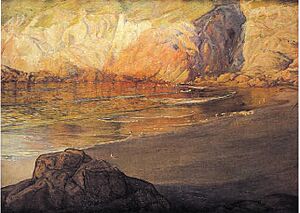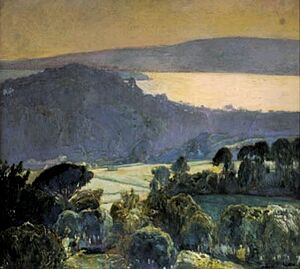Francisco Llorens Díaz facts for kids
Francisco Llorens Díaz (born April 10, 1874, in La Coruña; died February 11, 1948, in Madrid) was a Spanish painter from Galicia. He was most famous for his beautiful paintings of nature (landscapes) and everyday objects (still-lifes).
Early Life and Art Education
Francisco Llorens grew up in a family of merchants. While he was getting a business education, he also started taking drawing classes. He went to the School of Arts and Crafts in La Coruña. His teacher there was a military artist named Román Navarro.
These art classes made him want to be a painter instead of a businessman. So, he moved to Madrid. There, he joined the Real Academia de Bellas Artes de San Fernando, which is a famous art school. He learned from a well-known artist named Carlos de Haes. Francisco also finished his early training in the workshops of Joaquín Sorolla, another very famous Spanish painter.
Travels and Exhibitions
Francisco Llorens received a special grant that allowed him to travel. He went to the Academia de España en Roma in Rome, Italy. He also traveled to Belgium and the Netherlands with other students. He spent several months studying art in the city of Bruges, which he really loved.
Three of the paintings he created in Rome were bought by the Spanish ambassador. They were displayed in the Quirinal Palace, an important building. Francisco returned to Spain in 1906.
Over the next 20 years, he showed his art in many exhibitions. In 1917, he displayed his work at the Second Exposition of Galician Art. In the same year, he had a show with his friend Fernando Álvarez de Sotomayor at the Galerías Layetanas in Barcelona. His paintings were also shown in Panama and Buenos Aires, even though he never visited America himself.
In 1922, he won a top award at the National Exhibition of Fine Arts. He won for his landscape painting called "Rías Baixas." In 1929, he was asked to help organize the Galician section at the Ibero-American Exposition.
Later Life and Legacy
In 1918, Francisco married Eva Rodríguez. She was the daughter of a well-known doctor in La Coruña. Sadly, Eva passed away in 1925, leaving him with two daughters. Soon after, he received a high honor called the Grand Cross of the Order of Charles III.
During the Spanish Civil War, he stayed in Madrid until 1938. Then, he and his daughters moved to Valencia with the Republican army. While there, he focused on painting still-lifes.
After the war, he spent his time between Madrid and Galicia. In Galicia, he continued to paint landscapes. In 1942, he became an Academician at his old art school, the Real Academia. The next year, he received similar honors at the Real Academia Gallega.
In 1945, Francisco's health began to get worse. He started to have problems with his memory. He passed away in 1948 and was buried next to his wife.
In 1972, a large show of his art was held in Madrid. More exhibitions followed in La Coruña and Vigo. You can see his paintings in many museums and collections in Galicia. These include the Museo Provincial de Lugo, Museo de Bellas Artes de La Coruña, Museo de Pontevedra, and the Museo Quiñones de León. The famous Museo del Prado in Madrid also has eight of his artworks.
See also
 In Spanish: Francisco Llorens Díaz para niños
In Spanish: Francisco Llorens Díaz para niños




